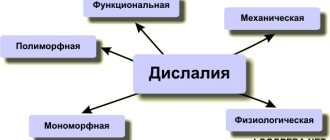12/03/2013 How to correctly assess the state of your child’s speech? How and when should a child speak? In what cases should you worry, and in what cases should you just wait? How not to miss the moment when he may need the help of specialists? These and other difficult questions are asked by those parents who care about how their children will grow up.
Often parents pay attention to how their child speaks - whether he pronounces all the sounds correctly. It seems to parents that the main indicator for assessing a child’s speech development is correct sound pronunciation. But this is only one of the components of speech development. Other, no less important, is the development of the child’s vocabulary, the ability to formulate his statement grammatically correctly and consistently. To understand whether your child has a speech disorder, you need to consider what types of speech disorders exist.
All types of disorders based on psychological and linguistic criteria can be divided into two groups: oral and written speech.
Dislalia
Dyslalia (dis - disorder, lalia - speech) is a violation of sound pronunciation with normal hearing and intact innervation of the speech apparatus.
Dyslalia is divided into mechanical (associated with damage or abnormal development of the organs of articulation as a result of injury or thumb sucking habit) and functional (not associated with such damage).
Disorders of the structure of the articulatory apparatus include abnormal structure of the jaws (bad bite), teeth, palate (too high, too low, cleft), tongue (massive, too small, shortened hyoid ligament).
With timely speech therapy assistance, dyslalia is quickly and irrevocably compensated for in children. In adults, too, the prognosis is good.
PRACTICE EXAMPLES
Nikolay, 26 years old. He applied with a violation of the sound pronunciation of the sound “R, R” and pronounced it correctly. 4 lessons were held. We did not expect such a quick and dramatic result. The control session after 3 months confirmed the complete automation of sound. I studied a lot on my own.
Sergey, 22 years old. I contacted him regarding a violation of the sound pronunciation of “R, R” . The cause of the violation was: malocclusion, shortened hyoid ligament. After the operation to trim the frenulum and correct the bite, a course of speech therapy classes (10 lessons) was conducted, resulting in complete automation of sounds in independent speech.
Oral speech disorders
Dislalia
- violation of sound pronunciation. With dyslalia, hearing and innervation of the muscles of the speech apparatus remain intact. Impaired sound pronunciation in dyslalia is associated with an anomaly in the structure of the articulatory apparatus or features of speech education. A child with dyslalia may have difficulty pronouncing one or more sounds that are difficult to articulate. Violations of sound pronunciation can manifest themselves in the absence of certain sounds, distortion of sounds or their replacement.
Rhinolalia
- a violation of sound pronunciation and voice timbre associated with a congenital anatomical defect in the structure of the articulatory apparatus. The anatomical defect manifests itself in the form of a cleft on the upper lip, gum, hard and soft palate. Often clefts are combined with various dental anomalies.
The speech of a child with rhinolalia is characterized by slurring due to the nasality of the voice (nasality) and impaired pronunciation of many sounds. The wider the cleft, the stronger its negative impact on the formation of the sound side of speech. Disturbances in the structure and activity of the speech apparatus in rhinolalia affect all structural components of the language system.
Voice disorder
is the absence or disorder of voice formation due to pathological changes in the vocal apparatus.
A distinction is made between partial voice impairment—dysphonia—and complete absence of voice—aphonia. Voice disorders arise as a result of chronic inflammatory processes of the vocal apparatus or its anatomical changes, vocal fatigue, and various infectious diseases. The voice of a person suffering from dysphonia is perceived by the listener as hoarse, hoarse, dry, exhausted, with a small range of vocal modulations.
Dysarthria
- a violation of the sound-pronunciation and melodic-intonation aspects of speech, caused by insufficient innervation of the muscles of the speech apparatus.
Dysarthria is associated with organic damage to the nervous system, as a result of which the motor side of speech is disrupted, the tone of the muscles of the articulatory apparatus is increased or decreased. The cause of dysarthria in childhood is damage to the nervous system, mainly in the prenatal or childbirth period.
With dysarthria, sound pronunciation disorders are observed: distortions, lack of confusion, substitutions, undifferentiated pronunciation of sounds. Speech is “blurred”, poorly intonated, inexpressive. The pace of speech can be either accelerated or slow.
Bradylalia and tachylalia
are united under the general name - violation of the tempo of speech.
Bradylalia
- pathologically slow speech rate.
It manifests itself in a slow pace of oral speech and mental activity, slowness of reading and writing, monotony of voice, lengthening of pauses between words, extended pronunciation of speech sounds.
Tahilalia
- pathologically accelerated rate of speech.
At an accelerated pace, speech is characterized by uncontrollable, swiftness, haste, and assertiveness. Acceleration of speech is accompanied by hesitation, stumbling, repetition, swallowing and rearrangement of syllables, distortion of sentences, and unclear pronunciation of phrases.
Stuttering
- disturbance of fluency of speech caused by muscle spasms of the speech apparatus.
Stuttering usually begins in children between the ages of 2 and 6 years. It can appear in children as a result of excessive speech load, mental trauma, or in children with delayed speech development as a result of damage to certain structures of the central nervous system.
The main manifestation of stuttering is muscle spasms of the speech apparatus, which occur only at the moment of speaking or when trying to start speaking. The speech of people who stutter is characterized by repetitions of sounds, syllables or words, prolongation of sounds, breaking of words, insertion of additional sounds or words. Often, the convulsive speech of people who stutter is accompanied by accompanying movements: closing the eyes, flaring the wings of the nose, various head movements, and stamping. People who stutter often use insertion words like: here, this, well, etc. in their speech, which are repeated in a variety of ways throughout the entire utterance.
Aphasia
- complete or partial loss of speech caused by local brain lesions.
A child loses speech as a result of traumatic brain injury, neuroinfection, or brain tumors after speech has been formed.
Alalia
- absence or underdevelopment of speech in children due to organic brain damage.
Alalia is one of the most severe and complex speech defects. This speech pathology is characterized by the late appearance of speech (after 3 years), its slow development, and significant limitation of both passive and active vocabulary. Speech development in this disorder follows a pathological path. There are two forms of alalia: motor and sensory.
With motor alalia
the sound image of the word is not formed; simplifications of the syllabic structure of words, omissions, rearrangements and replacements of sounds, syllables, and words in a phrase are typical. The acquisition of grammatical structures of the language suffers significantly.
Sensory alalia
characterized by impaired perception and understanding of speech with full physical hearing. Children with sensory alalia either do not understand speech addressed to them at all, or their understanding of speech is limited to the usual everyday situation. Children with sensory alalia are very sensitive to sound stimuli. Speech delivered in a quiet voice is perceived better by them. Such children are characterized by the phenomenon of echolalia, i.e. repetition of heard words or short phrases without comprehension. Often children with sensory alalia give the impression of being deaf or mentally handicapped.
Dysarthria
Dysarthria is a violation of sound pronunciation caused by insufficient innervation of the speech apparatus (organic damage to the central part of the speech motor analyzer).
The speech of a dysarthric person is slurred, incomprehensible to others, like “porridge in the mouth.” The articulation of many groups of sounds is impaired: hissing, whistling, sonorants, and sometimes vowels. Speech breathing is shallow, arrhythmic. Hypersalivation (increased salivation) is observed. The mobility and sensitivity of the speech muscles suffers. Dysarthric has difficulty finding an articulatory posture (licking lips, placing tongue behind upper teeth, etc.). Impaired sound pronunciation with dysarthria is one of the symptoms of a more complex speech disorder. Speech hearing and auditory differentiation of sounds also suffer, a poor vocabulary, and unformed grammatical structure of speech are observed. Secondary mental layers (behavioral problems) are also observed. All these difficulties lead to persistent poor performance in school (dysgraphia, dyslexia, dysorthography).
Despite its similarities with dyslalia, dysarthria is a more complex and persistent disorder that requires help and psychological support.
In adults, correction of dysarthria is even slower than in children, but it is possible.
Case from practice
Kolya, 5 years old. The sound pronunciation of the sounds Ш, Ж, Х, Л, Л, Р, Рь is impaired . There is hypersalivation and difficulty in repeating the articulatory pattern. Phonemic processes are disrupted, lexico-grammatical structure is disrupted. As a result of 3 courses of correctional classes, dysarthria was compensated, sounds were automated, work continues on coherent speech, improving vocabulary and grammar.
Find out more about the Center's services and sign up for a consultation or lesson
You can call (812)
640-90-77
, or by filling out the form below.
Speech apparatus defects
The speech apparatus is a set of organs that are involved in sound pronunciation and speech formation. It consists of 2 sections: central and peripheral. The central part includes the brain, and the peripheral part includes muscles, bones, cartilage, and ligaments. Therefore, when we talk about disorders in the peripheral region, we are talking about the tongue, lips, soft palate and lower jaw. Disruption of the functioning of one or several organs of the speech apparatus at the same time leads to the appearance of speech disorders.
Defects of the speech apparatus, from a diagnostic point of view, can be divided into 2 groups. The first group will include disorders that are diagnosed at an early age; more often, already in the first month of a child’s life, examination reveals disorders that can only be corrected surgically.
The second group includes disorders that cannot be diagnosed at an early age. Their presence becomes known during the development of speech, most often at 2-2.5 years. In this case, you should seek help from a pediatric speech therapist. At the first consultation, the speech therapist will diagnose the disorders and, if necessary, refer you to related specialists.
If the first symptoms of speech disorders occur, you should immediately contact a speech therapist for diagnosis and selection of a correct and effective correction program.
Parents should contact a specialist if they notice:
- Stuttering or pronunciation of words too slow/fast, pauses between words;
- Voice disturbances, nasality, changes in voice timbre;
- Distortion or “swallowing” of sounds, inaudible speech, and others.
Our center’s specialists successfully work with speech apparatus defects; the following methods are most often used to correct speech disorders:
- Speech therapy massage;
- Special speech therapy exercises;
- DENAS therapy;
- Classes using Forbrain (the device can also be purchased for home use);
- Exercises for speech breathing and others.
The most common speech apparatus defects and methods of their correction:
Dysphonia (aphonia) is popularly called “voice disorder” or “vocal disorder”. Signs: lack of phonation or changes in the strength and timbre of the voice, nasality or hoarseness. Requires urgent correction, since with age the symptoms intensify and are less amenable to correction. In the treatment of dysphonia, articulation and breathing exercises, massage of the collar area, and exercises with the DENAS apparatus are most often used.
Stuttering is a disturbance in the tempo, rhythm and fluency of speech caused by convulsions of the speech apparatus. In children, it most often occurs during the development of phrasal speech. In the absence of timely correction, stuttering can accompany a person into adulthood. This disorder is difficult to correct due to its obsessive nature. Treatment of stuttering at the Ember Center is aimed at eliminating the pathological factors that led to the onset of stuttering, as well as neutralizing its consequences, fear of speech - logophobia. It is thanks to an integrated approach that it is possible to get rid of stuttering not temporarily, but forever.
A short frenulum is a defect of the oral cavity, which, as a rule, is congenital. With this disorder, the child cannot pronounce some sounds. Often, with a short frenulum, it is recommended to solve the problem surgically, especially at an early age, when the work of a speech therapist is not yet possible. But this can often be avoided with timely contact with a speech therapist. With the help of special exercises, you can stretch the frenulum, thereby solving this problem.
A dome-shaped palate is a defect of the speech apparatus caused by the incorrect structure of the oral cavity. The speech therapist teaches how to pronounce sounds that are inaccessible to the client, which will not differ from traditional ones by ear.
Rhinolalia (cleft palate) is characterized by a defective structure and functioning of the speech apparatus. A cleft palate interferes with normal voice production. A person with such a defect grossly distorts sounds, pronounces words nasally, and his voice timbre changes. In the treatment of such disorders, a surgical method is often used, after which a course of sessions with a speech therapist is required.
Dysarthria is a violation of the muscle tone of the articulatory apparatus, which contributes to the development of speech production disorders. With dysarthria, speech motor skills, breathing, voice and pronunciation of sounds are impaired. In this case, correctional classes with a speech therapist are aimed at eliminating the cause of the violations. The specialist uses articulation gymnastics, speech therapy massage, and DENAS therapy.
Defects of the speech apparatus are often found in people, but it is in childhood that they can be most effectively treated. With age, correction of these violations becomes more difficult and time-consuming.
Correction of speech apparatus defects at the Ember center is carried out according to an individually developed program. For complex disorders, we recommend a joint consultation with several specialists: a clinical psychologist, a speech pathologist, a special education teacher, and a neuropsychologist. An integrated approach helps to accurately determine the diagnosis and its causes, develop a correction route, without missing important details.
If your child has a speech defect that interferes with normal speech, sign up for a consultation by calling +7 (812) 642-47-02 or leave a request on the website.
The relationship between sound pronunciation disorders and structural anomalies of the organs of articulation
Bibliographic description:
Bogatyreva, A.V. Relationship between disturbances in sound pronunciation and anomalies in the structure of the organs of articulation / A.V. Bogatyreva. — Text: direct // Pedagogical skills: materials of the IX International. scientific conf. (Moscow, November 2016). - Moscow: Buki-Vedi, 2016. - pp. 23-24. — URL: https://moluch.ru/conf/ped/archive/208/11317/ (access date: 01/03/2022).
Recently, according to statistics, there is a tendency to a significant increase in the number of children with speech disorders. Speech disorders are varied in nature, but for parents the most obvious and significant aspect of speech is the sound-pronunciation side of speech, which is why they turn to speech therapists. The speech of young children during its formation may be characterized by shortcomings in sound pronunciation, but all age-related “irregularities” in sound pronunciation normally disappear in children by the age of 4–5 years. However, for various reasons, in some children, age-related sound pronunciation defects do not disappear, but become persistent, and this speech disorder is called dyslalia. One of the causes of mechanical dyslalia is anatomical defects in the peripheral part of the speech apparatus (tongue, lips, teeth, upper and lower jaw, soft and hard palate). Among the anomalies of the organs of articulation that predispose to impaired pronunciation of speech sounds, the most common are: shortened frenulum of the tongue and lips, as well as defects in the structure of the jaws, which leads to malocclusion. What is a bite, and what are these disorders?
Occlusion - the relative position of the upper and lower dental arches when closing relative to each other. A bite is considered normal when, when closed, the upper teeth overlap the lower teeth by 1/3. Unfortunately, recently, malocclusion is becoming more and more common in children. Of the 38 five-year-old children we examined, 16 of them had malocclusion, which is 42%. What are these violations?
‒ the upper jaw protrudes strongly forward, as a result of which the lower front teeth do not meet the upper teeth (distal bite)
‒ the lower jaw protrudes forward, the front teeth of the lower jaw protrude in front of the front teeth of the upper jaw (mesial bite)
‒ a gap remains between the teeth of the upper and lower jaws when they are closed (open bite)
‒ external or internal deviation of the teeth of the lower dental arch relative to the upper in the lateral direction (crossbite)
More than 75% of the growth of a child’s maxillofacial structures occurs between the ages of 1 and 5 years (during the period of primary occlusion), and the sound pronunciation aspect of speech is formed in preschoolers from 2.8 to 5.5 years. That is, the earlier the anatomical defects of the organs of articulation appeared, the more likely it is that stable defects in the phonetic structure of speech will appear. What are the causes of anomalies of the organs of articulation? According to medical sources, about 30% are hereditary factors, and 70% are acquired anatomical defects. Therefore, it is very important to carry out educational work among parents, to promptly inform them about methods for preventing such anomalies and eliminating their causes.
Factors that can provoke pathology of the dental system and disturbances in sound pronunciation include:
1. Artificial feeding , long-term feeding of the child only through a pacifier (up to one year of age or more), lack of solid food in the child’s diet. The chewing function in children is formed by the time the chewing teeth erupt, i.e. by 2.5–3 years. If at this age a child is fed only soft and pureed food, the chewing function develops slowly due to the lack of the necessary load on the masticatory muscles.
2. Bad habits , which include:
prolonged sucking of a pacifier, sucking and biting of fingers, cheeks, lips, foreign objects (for example, corners of a blanket)
For example, sucking the lower lip and thumb leads to lengthening of the upper dental arch, and biting and sucking of the upper lip helps to lengthen the lower dental arch. Depending on which teeth the child places his finger between, non-occlusion of the teeth and displacement of the lower jaw are formed.
3. Respiratory dysfunction . Normally, a child should breathe through the nose (nasal breathing). Impaired nasal breathing due to frequent colds, chronic rhinitis, adenoids, tonsillitis, etc. leads to the fact that the child is forced to breathe through the mouth.
With the oral type of breathing, the child’s mouth is constantly half-open, the tongue is often in an interdental position, which leads to deformation of the facial skeleton, slower growth of the bones of the upper jaw, and disturbances in sound pronunciation.
4. Poor posture. An important condition for the normal development of the dental system is correct posture. Normally, the head and body form one vertical line. If a child has a forward position of the head relative to the spine, asymmetry of the shoulders and shoulder blades, this can lead to malocclusion. At risk are children who have a habitual incorrect position of the body and head during sleep.
- sleep on one side, with your hand or hand placed under your cheek, clenched into a fist.
‒ the habit of sleeping on your back, with your head thrown back or tilted onto your chest, which leads to impaired growth of the lower jaw.
‒ high head of the bed, when the child’s head leans forward (while the lower jaw moves forward)
And also: incorrect seating at the table, the habit of supporting your head with your palms, leaning on your elbows and your chin on your hand. All this causes asymmetric changes in the shoulder girdle, which can lead to the formation of a crossbite.
We have named some very common factors that predispose to the appearance of deformations in the structure of the dental system and disorders of the phonetic side of speech.
From all of the above it follows:
1.An important link in the prevention of speech disorders is the prevention of negative factors and the elimination of bad habits in children.
To correct already manifested anomalies of the dental system, orthodontists recommend performing myogymnastics (exercises to strengthen the maxillofacial muscles) with children from 2.5 to 3 years of age. With regular myogymnastics in children, the type of breathing is corrected, the orbicularis oris muscle is strengthened, and maxillofacial development is normalized.
2. Corrective work of a speech therapist on the formation of correct sound pronunciation in children with anatomical pathology of the organs of articulation should be carried out together with a dentist and orthodontist in order to achieve maximum results.
Literature:
- Speech therapy. Ed. L. S. Volkova, S. N. Shakhovskaya - M., VLADOS 1998
- Basics of speech therapy work with children. /Under general ed. G. V. Chirkina. - M., ARKTI, 2002
- Basics of speech therapy with a workshop on sound pronunciation. Volosovets T.V., Gorina N.V., Zvereva N.I., etc. - M., ACADEMY 2000
- Speech correction in children: an orthodontist’s view. Kostina Y. V., Chapala V. N. - Library of the journal "Speech therapist" - T. Ts. SPHERE 2008
- Diagnosis and correction of sound pronunciation disorders in children with mild anomalies of the organs of articulation. Grigorenko N. Yu., Tsybulsky S. A. - M., BOOK LOVER 2003
Key terms
(automatically generated)
: lower jaw, child, dentoalveolar system, upper jaw, tooth, malocclusion, impaired sound pronunciation, nasal breathing, crossbite, recent times.






